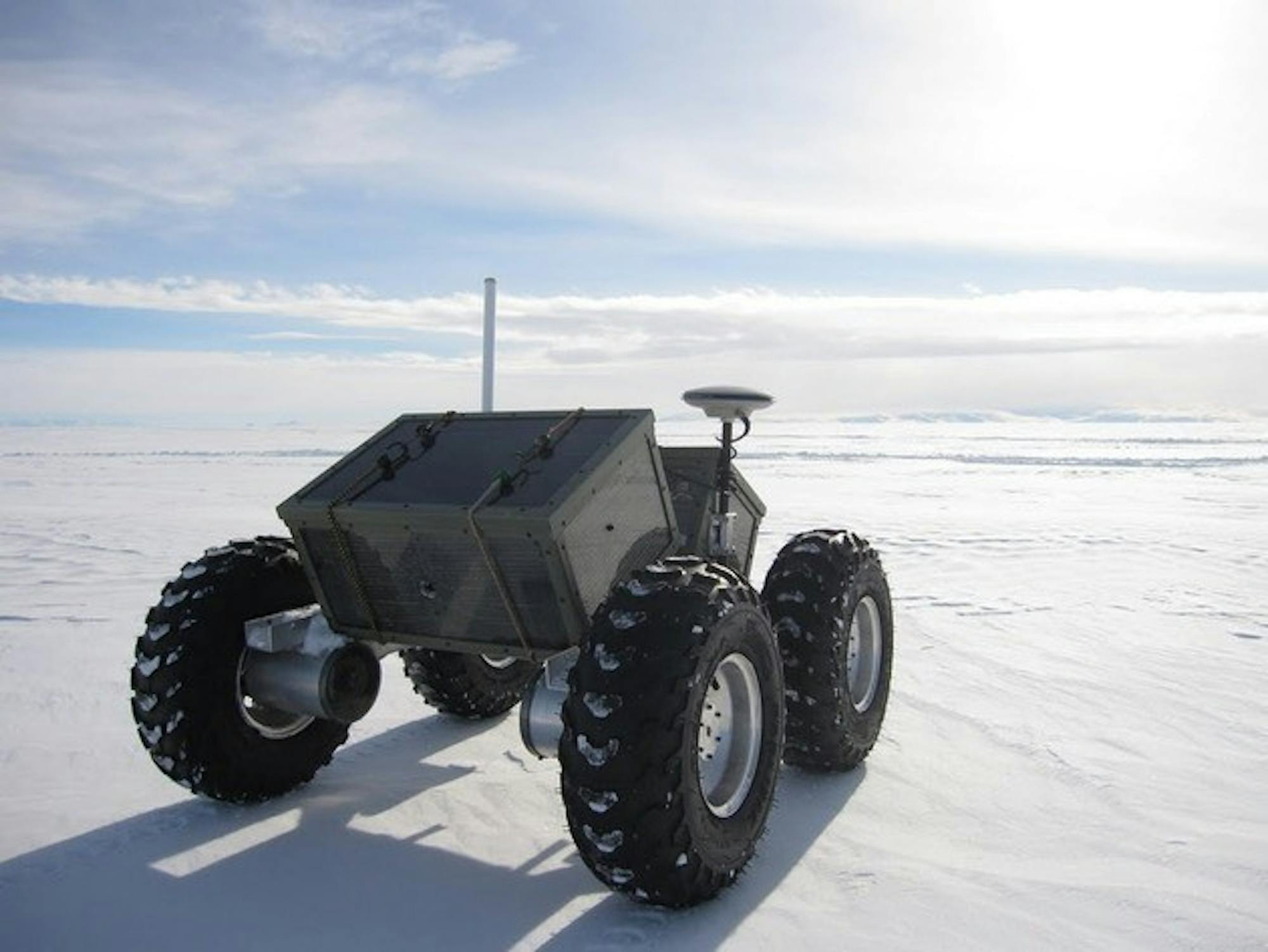Yeti, a lightweight, one square meter vehicle designed to travel over snow and rough terrain, uses ground-penetrating radar technology revolutionized by CRREL researcher Steven Arcone Th'77, a research geophysicist for the Yeti project, according to project participant Eric Tautmann '07 Th'09. The technology uses electromagnetic radiation to detect reflected signals from below the ground's surface.
The ground-penetrating radar "generates a continuous wave form of the layers it detects under the surface," and snow typically shows consistent horizontal banding, according to CRREL research Jim Lever, who co-leads the Yeti project with Thayer professor Laura Ray. When the radar detects a crevasse, the data show an "interference pattern that has a very characteristic appearance," Lever said.
The project began with the development of a different robot, called Cool Robot, by Lever and Ray. Students designed and created the solar-powered, four-wheel-drive rover to collect ice and air samples on "long-duration science missions in Greenland and Antarctica in lieu of putting people in the deep field," Lever said.
In 2007, Tautmann and five other studnets began working on Yeti, with the "specific operational objective of detecting crevasses in polar regions," according to Lever. The idea came from Arcone, who identified the problem of crevasse detection.
Observatories and astronomical research stations for the United States Antarctic Program, run by the National Science Foundation's Office of Polar Programs, can often only be accessed via air or long polar traverses, according to Arcone.
In Antarctica and Greenland, these stations require large amounts of fuel that must be transported from the coasts. In the past, each fuel-transporting flight by a Lockheed C-130 Hercules airplane cost the NSF $8,000, according to Arcone.
More recently, track vehicles driven by two people have transported fuel to the research stations, Arcone said. The treacherous overland route from Thule Air Base to NSF's Summit Greenland Observatory on the Greenland Ice Cap stretches hundreds of miles.
Crevasses large cracks in ice sheets that can become up to 30 feet wide and 200 feet deep pose the "main threat to life and safety in Antarctica," Arcone said. Crevasses are particularly dangerous because snow often accumulates on top of the cracks, forming snow bridges that make the crevasses difficult to see.
"In order to get up onto the ice cap, you have to explore a crevasse-free route," Lever said.
Tractors traversing ice sheets normally use ground-penetrating radar suspended on booms about 30 feet in front of the vehicle, Trautmann said. This gives the operators of the vehicle about 2.5 seconds to stop when a crevasse is detected, according to Trautmann.
"Yeti does exactly the same thing, but you can program it a route and have it drive a route in front of the lead vehicle, and it will use the radar to find where the crevasses are," he said.
After two academic terms of working on Yeti, Tautmann and another student continued to work on the robot full time. Lever, who was traveling to Greenland in spring 2008, gave the students the opportunity to accompany him and test Yeti on a traverse of the Greenland Ice Cap.
"The students involved put in a superhuman effort to get Yeti ready in time," Lever said.
In Greenland, the students showed that Yeti could travel across rough snow, and Lever tested the robot in controlled crevasse fields. Since then, Yeti has travelled to both Antarctica and Greenland several times and has proven useful in detecting cracks in the ice, he said.
Trautmann said that the guidance of CRREL researchers like Lever and Arcone, who have spent time in polar regions and understand their challenges, has been invaluable to the project.
"The key was to be able to work with people who had actually been there and knew the requirements and what would actually be useful," Trautmann said.
Yeti is currently in Greenland undergoing its final stage of testing and repairs, according to Suk Joon Lee '11, who designed the driving code of the robot and the interface between the robot and the instrument package for his senior thesis. Lee is currently in Greenland with Yeti.
"After this deployment, [the] testing stage of the robot will be completed, and the robot will be fully functional for its given tasks," Lee said.
Rebecca Williams, an engineering PhD candidate studying with Ray, is working to have Yeti instantly process the data it receives from the ground penetrating radar, according to Lever. Currently, Yeti can only record data and must travel back to the operator, who then analyzes the data to determine the location of crevasses, according to Arcone.
In addition to using ground-penetrating radar technology, Yeti can collect "air particulate matter data in order to measure the pollution created by the scientific camps in the polar region," using an instrument package developed by University of New Hampshire researchers, Lee said. Yeti can also measure snow field patterns which can be used to model the physics of snow patterns and wind, according to Lee.
Ground-penetrating radar technology can also be used to find optimum sites for drilling ice cores long cylinders of ice that can be analyzed for a variety of substances, including oxygen isotopes that can substitute as temperature indicators and for glaciological and climate research.
"It's very likely that if the concept behind Yeti gains some traction, they'll start building a bunch of these things," Trautmann said.
Yeti's technology may soon be transferred to Cool Robot, which can run far longer than Yeti's three-hour battery life because the former is solar-powered, Lee said. Cool Robot could then be used in months when daylight was longer, while Yeti would continue to be used in darker months.
Funding for Yeti came from both contracts and small grants from the NSF, according to Arcone. The project also received a $25,000 grant from NASA's Jet Propulsion Laboratory, according to Trautman.
Ray was unavailable for comment by press time.




